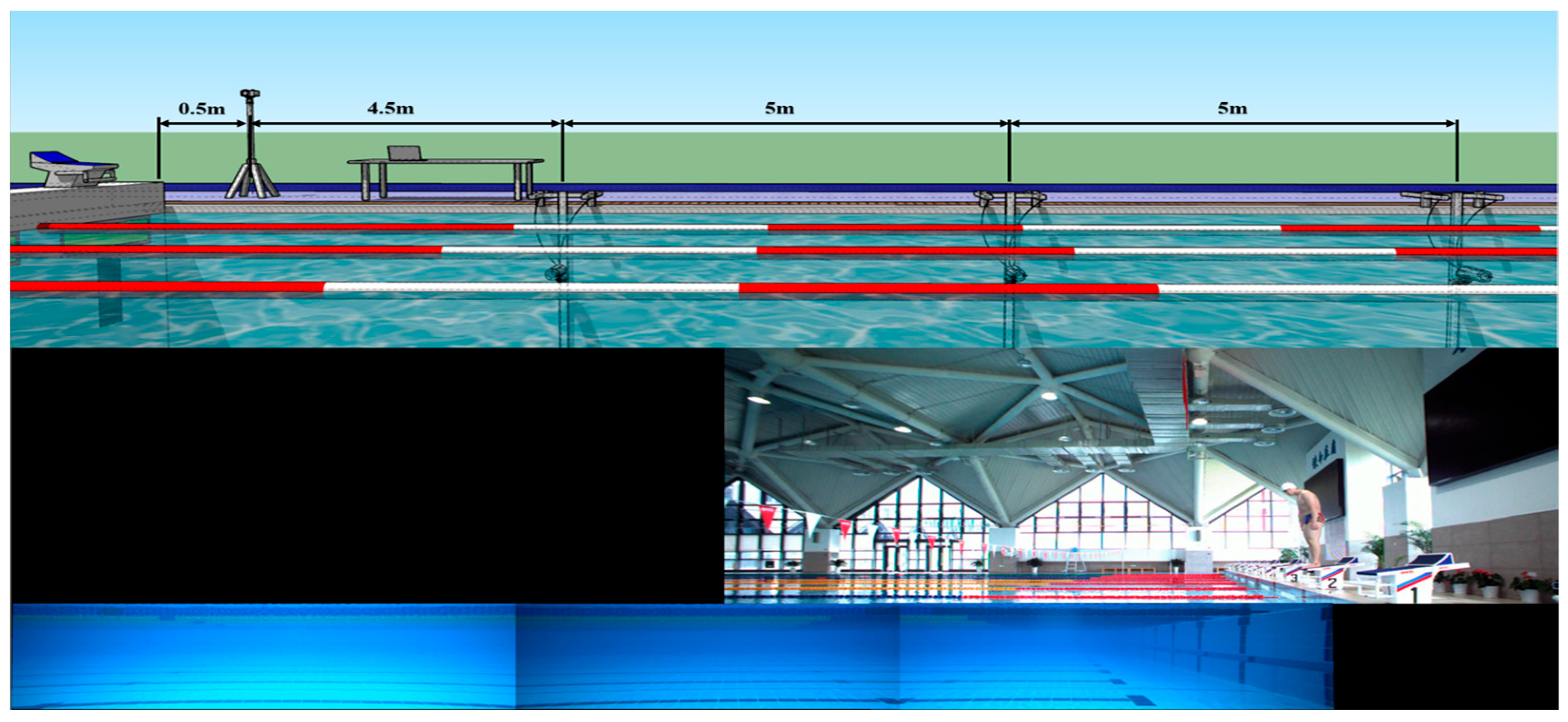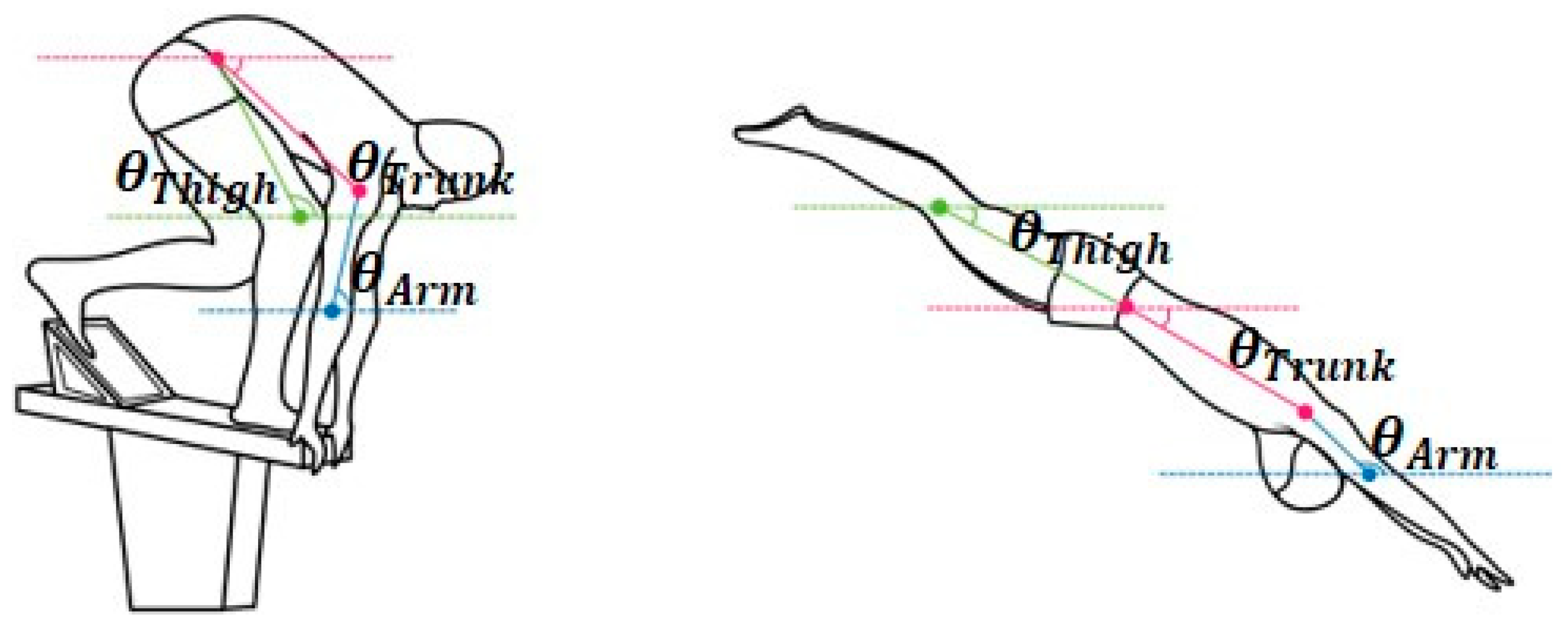Inter-Segmental Coordination of the Swimming Start among Paralympic Swimmers: A Comparative Study between S9, S10, and S12 Swimmers
Abstract
:1. Introduction
2. Materials and Methods
2.1. Participants
2.2. Measurement System
2.3. Experimental Protocol and Procedures
2.4. Data Processing
2.5. Statistical Analysis
2.6. Continuous Relative Phase
3. Results
4. Discussion
5. Conclusions
Author Contributions
Funding
Institutional Review Board Statement
Informed Consent Statement
Data Availability Statement
Conflicts of Interest
References
- Mason, B.; Alcock, A.; Fowlie, J. A kinetic analysis and recommendations for elite swimmers performing the sprint start. In Proceedings of the ISBS-Conference Proceedings Archive, Ouro Preto, Brazil, 23–27 August 2007. [Google Scholar]
- Cossor, J.; Mason, B. Swim start performances at the Sydney 2000 Olympic Games. In Proceedings of the ISBS-Conference Proceedings Archive, Ouro Preto, Brazil, 1–5 July 2001. [Google Scholar]
- Tor, E.; Pease, D.L.; Ball, K.A.; Hopkins, W.G. Monitoring the effect of race-analysis parameters on performance in elite swimmers. Int. J. Sports Physiol. Perform. 2014, 9, 633–636. [Google Scholar] [CrossRef] [PubMed]
- De Natation, F.I. FINA Swimming Rules; Fédération Internationale de Natation: Lausanne, Switzerland, 2017. [Google Scholar]
- Vantorre, J.; Seifert, L.; Fernandes, R.; Boas, J.V.; Chollet, D. Kinematical profiling of the front crawl start. Int. J. Sports Med. 2010, 31, 16–21. [Google Scholar] [CrossRef] [PubMed]
- Vantorre, J.; Chollet, D.; Seifert, L. Biomechanical analysis of the swim-start: A review. J. Sports Sci. Med. 2014, 13, 223–231. [Google Scholar] [PubMed]
- Cuenca-Fernández, F.; López-Contreras, G.; Arellano, R. Effect on swimming start performance of two types of activation protocols: Lunge and YoYo squat. J. Strength Cond. Res. 2015, 29, 647–655. [Google Scholar] [CrossRef] [PubMed]
- Vilas-Boas, J. Biomechanical Analysis of Ventral Swimming Starts; University of Saint Etienne: Saint Etienne, France, 2003; Volume 12, pp. 331–333. [Google Scholar]
- Ruschel, C.; Araujo, L.G.; Pereira, S.M.; Roesler, H. Kinematical analysis of the swimming start: Block, flight and underwater phases. In Proceedings of the ISBS-Conference Proceedings Archive, Ouro Preto, Brazil, 23–27 August 2007. [Google Scholar]
- Beretić, I.; Đurović, M.; Okičić, T.; Dopsaj, M. Relations between lower body isometric muscle force characteristics and start performance in elite male sprint swimmers. J. Sports Sci. Med. 2013, 12, 639–645. [Google Scholar]
- Song, Y.; Cen, X.; Chen, H.; Sun, D.; Munivrana, G.; Bálint, K.; Bíró, I.; Gu, Y. The influence of running shoe with different carbon-fiber plate designs on internal foot mechanics: A pilot computational analysis. J. Biomech. 2023, 153, 111597. [Google Scholar] [CrossRef]
- Ödek, U.; Korkusuz, F.; Kirazci, S. Block slope is the main determinant of block phase performance in swimming. Rev. Bras. Med. Esporte 2021, 27, 30–35. [Google Scholar] [CrossRef]
- Zheng, K. Research on the Physiological Monitoring and Evaluation of Pre-Competition Altitude Training for Zhejiang Elite Swimmers. Phys. Act. Health 2021, 5, 64–70. [Google Scholar] [CrossRef]
- Welcher, R.L.; Hinrichs, R.N.; George, T.R. Front-or rear-weighted track start or grab start: Which is the best for female swimmers? Sports Biomech. 2008, 7, 100–113. [Google Scholar] [CrossRef]
- Slawson, S.; Chakravorti, N.; Conway, P.; Cossor, J.; West, A. The effect of knee angle on force production, in swimming starts, using the OSB11 block. Procedia Eng. 2012, 34, 801–806. [Google Scholar] [CrossRef] [Green Version]
- Blanksby, B.; Nicholson, L.; Elliott, B. Swimming: Biomechanical analysis of the grab, track and handle swimming starts: An intervention study. Sports Biomech. 2002, 1, 11–24. [Google Scholar] [CrossRef] [PubMed]
- Takeda, T.; Takagi, H.; Tsubakimoto, S. Effect of inclination and position of new swimming starting block’s back plate on track-start performance. Sports Biomech. 2012, 11, 370–381. [Google Scholar] [CrossRef] [PubMed]
- Fischer, S.; Kibele, A. The biomechanical structure of swim start performance. Sports Biomech. 2016, 15, 397–408. [Google Scholar] [CrossRef] [PubMed]
- Kurz, M.; Stergiou, N. Applied dynamic systems theory for the analysis of movement. In Innovative Analyses of Human Movement; Human Kinetics: Champaign, IL, USA, 2004; pp. 93–119. [Google Scholar]
- Kelso, J.S. Dynamic Patterns: The Self-Organization of Brain and Behaviour; MIT Press: Cambridge, MA, USA, 1995. [Google Scholar]
- Amazeen, P.G.; Amazeen, E.L.; Turvey, M.T. Dynamics of human intersegmental coordination: Theory and research. In Timing of Behavior: Neural, Psychological, and Computational Perspectives; MIT Press: Cambridge, MA, USA, 1998. [Google Scholar]
- Hamill, J.; van Emmerik, R.E.; Heiderscheit, B.C.; Li, L. A dynamical systems approach to lower extremity running injuries. Clin. Biomech. 1999, 14, 297–308. [Google Scholar] [CrossRef]
- Lathouwers, E.; Baeyens, J.-P.; Tassignon, B.; Gomez, F.; Cherelle, P.; Meeusen, R.; Vanderborght, B.; de Pauw, K. Continuous relative phases of walking with an articulated passive ankle–foot prosthesis in individuals with a unilateral transfemoral and transtibial amputation: An explorative case–control study. Biomed. Eng. Online 2023, 22, 14. [Google Scholar] [CrossRef]
- Bartlett, R.; Wheat, J.; Robins, M. Is movement variability important for sports biomechanists? Sports Biomech. 2007, 6, 224–243. [Google Scholar] [CrossRef]
- Burgess-Limerick, R.; Abernethy, B.; Neal, R.J. Relative phase quantifies interjoint coordination. J. Biomech. 1993, 26, 91–94. [Google Scholar] [CrossRef]
- Chardonnens, J.; Favre, J.; Cuendet, F.; Gremion, G.; Aminian, K. Characterization of lower-limbs inter-segment coordination during the take-off extension in ski jumping. Hum. Mov. Sci. 2013, 32, 741–752. [Google Scholar] [CrossRef]
- Dingley, A.A.; Pyne, D.B.; Burkett, B. Relationships between propulsion and anthropometry in paralympic swimmers. Int. J. Sports Physiol. Perform. 2015, 10, 978–985. [Google Scholar] [CrossRef]
- Malone, L.A.; Sanders, R.H.; Schiltz, J.H.; Steadward, R.D. Effects of visual impairment on stroke parameters in Paralympic swimmers. Med. Sci. Sports Exerc. 2001, 33, 2098–2103. [Google Scholar] [CrossRef]
- Daly, D.; Einarsson, I.; van de Vliet, P.; Vanlandewijck, Y. Freestyle race success in swimmers with intellectual disability. Port. J. Sports Sci. 2006, 6, 294–296. [Google Scholar]
- Hammond, A.; Jeanes, R.; Penney, D.; Leahy, D. “I feel we are inclusive enough”: Examining swimming coaches’ understandings of inclusion and disability. Sociol. Sport J. 2019, 36, 311–321. [Google Scholar] [CrossRef] [Green Version]
- Chollet, D.; Chalies, S.; Chatard, J. A new index of coordination for the crawl: Description and usefulness. Int. J. Sports Med. 2000, 21, 54–59. [Google Scholar] [CrossRef] [PubMed] [Green Version]
- Osborough, C.D.; Payton, C.J.; Daly, D.J. Influence of swimming speed on inter-arm coordination in competitive unilateral arm amputee front crawl swimmers. Hum. Mov. Sci. 2010, 29, 921–931. [Google Scholar] [CrossRef] [PubMed]
- IPC. International Paralympic Committee, Classification. Available online: http://www.paralympic.org/ (accessed on 26 October 2007).
- Adnan, N.M.N.; Ab Patar, M.N.A.; Lee, H.; Yamamoto, S.-i.; Jong-Young, L.; Mahmud, J. Biomechanical analysis using Kinovea for sports application. IOP Conf. Ser. Mater. Sci. Eng. 2018, 342, 012097. [Google Scholar] [CrossRef]
- Pataky, T.C. One-dimensional statistical parametric mapping in Python. Comput. Methods Biomech. Biomed. Eng. 2012, 15, 295–301. [Google Scholar] [CrossRef] [PubMed]
- Kurz, M.J.; Stergiou, N. Effect of normalization and phase angle calculations on continuous relative phase. J. Biomech. 2002, 35, 369–374. [Google Scholar] [CrossRef]
- Scholz, J.; Kelso, J. A quantitative approach to understanding the formation and change of coordinated movement patterns. J. Mot. Behav. 1989, 21, 122–144. [Google Scholar] [CrossRef]
- Bardy, B.G.; Oullier, O.; Bootsma, R.J.; Stoffregen, T.A. Dynamics of human postural transitions. J. Exp. Psychol. Hum. Percept. Perform. 2002, 28, 499. [Google Scholar] [CrossRef]
- Seifert, L.; Leblanc, H.; Chollet, D.; Delignières, D. Inter-limb coordination in swimming: Effect of speed and skill level. Hum. Mov. Sci. 2010, 29, 103–113. [Google Scholar] [CrossRef] [Green Version]
- Daly, D.; Martens, J.; Seifert, L.; Chollet, D.; Mujika, I. Competitive Swimming and Disabilities; Nova Science Publishers Inc.: Hauppauge NY, USA, 2011; Volume 1, pp. 459–480. [Google Scholar]
- Ravensbergen, H.J.C.; Genee, A.D.; Mann, D.L. Expert consensus to guide the classification of Paralympic swimmers with vision impairment: A Delphi study. Front. Psychol. 2018, 9, 1756. [Google Scholar] [CrossRef] [PubMed]
- Burkett, B.; Mellifont, R.; Mason, B. The influence of swimming start components for selected Olympic and Paralympic swimmers. J. Appl. Biomech. 2010, 26, 134–141. [Google Scholar] [CrossRef] [PubMed] [Green Version]
- Trembley, J.; Fielder, G. Starts, turns and finishes. In The Swim Coaching Bible; Human Kinetics, Inc.: Champaign, IL, USA, 2001; pp. 189–206. [Google Scholar]
- Erickson, G.B. Sports Vision: Vision Care for the Enhancement of Sports Performance; Elsevier Health Sciences: Amsterdam, The Netherlands, 2020. [Google Scholar]
- Ilbilge, O. Biomechanical structure of sprint start and effect of biological feedback methods on sprint start performance. Turk. J. Sport Exerc. 2014, 16, 72–79. [Google Scholar]
- Nicholson, V.P.; Spathis, J.G.; Hogarth, L.W.; Connick, M.J.; Beckman, E.M.; Tweedy, S.M.; Payton, C.J.; Burkett, B.J. Establishing the reliability of a novel battery of range of motion tests to enable evidence-based classification in Para Swimming. Phys. Ther. Sport 2018, 32, 34–41. [Google Scholar] [CrossRef] [PubMed] [Green Version]
- Cavaggioni, L.; Trecroci, A.; Tosin, M.; Iaia, F.M.; Alberti, G. Individualized dry-land intervention program for an elite Paralympic swimmer. J. Sports Med. Phys. Fit. 2018, 59, 82–86. [Google Scholar] [CrossRef]
- Dingley, A.A.; Pyne, D.B.; Youngson, J.; Burkett, B. Effectiveness of a dry-land resistance training program on strength, power, and swimming performance in paralympic swimmers. J. Strength Cond. Res. 2015, 29, 619–626. [Google Scholar] [CrossRef] [Green Version]
- Achten, J.; Jeukendrup, A.E. Heart rate monitoring: Applications and limitations. Sports Med. 2003, 33, 517–538. [Google Scholar] [CrossRef]
- Wang, S. Pattern-Matching Kinematic Analysis of Glide Phase after Start with Different Techniques in Medley Swimming: An Olympic Champion Case. Phys. Act. Health 2022, 6, 246–256. [Google Scholar] [CrossRef]
- Peters, B.T.; Haddad, J.M.; Heiderscheit, B.C.; van Emmerik, R.E.; Hamill, J. Limitations in the use and interpretation of continuous relative phase. J. Biomech. 2003, 36, 271–274. [Google Scholar] [CrossRef]






| Group | Type of Disability | Number | Age (Year) | Weight (kg) | Height (cm) |
|---|---|---|---|---|---|
| S9 | Lower limb/Upper limb | 6 | 17.2 ± 2.3 | 52.2 ± 6.9 | 170.4 ± 4.3 |
| S10 | Lower limb/Upper limb | 7 | 23.4 ± 5.9 | 75.4 ± 6.2 | 179.4 ± 2.8 |
| S12 | Visual impairments | 8 | 20.8 ± 3.7 | 71.8 ± 7.6 | 180.7 ± 7.9 |
| Phase Duration (%)/Groups | S9 | S10 | S12 | p-Value |
|---|---|---|---|---|
| Block phase | 40.33% ± 2.30 | 38.83% ± 1.75 | 38.07% ± 4.46 | 0.219 |
| Flight phase | 21.35% ± 1.23 | 22.04% ± 2.71 | 14.39% ± 9.13 | 0.000 * |
| Entry water phase | 20.56% ± 1.66 | 23.38% ± 1.93 | 25.24% ± 1.99 | 0.856 |
Disclaimer/Publisher’s Note: The statements, opinions and data contained in all publications are solely those of the individual author(s) and contributor(s) and not of MDPI and/or the editor(s). MDPI and/or the editor(s) disclaim responsibility for any injury to people or property resulting from any ideas, methods, instructions or products referred to in the content. |
© 2023 by the authors. Licensee MDPI, Basel, Switzerland. This article is an open access article distributed under the terms and conditions of the Creative Commons Attribution (CC BY) license (https://creativecommons.org/licenses/by/4.0/).
Share and Cite
Zhou, Z.; Li, S.; Yang, L.; Gao, Z.; Lin, Y.; Radak, Z.; Gu, Y. Inter-Segmental Coordination of the Swimming Start among Paralympic Swimmers: A Comparative Study between S9, S10, and S12 Swimmers. Appl. Sci. 2023, 13, 9097. https://doi.org/10.3390/app13169097
Zhou Z, Li S, Yang L, Gao Z, Lin Y, Radak Z, Gu Y. Inter-Segmental Coordination of the Swimming Start among Paralympic Swimmers: A Comparative Study between S9, S10, and S12 Swimmers. Applied Sciences. 2023; 13(16):9097. https://doi.org/10.3390/app13169097
Chicago/Turabian StyleZhou, Zhanyi, Shudong Li, Luqi Yang, Zixiang Gao, Yi Lin, Zsolt Radak, and Yaodong Gu. 2023. "Inter-Segmental Coordination of the Swimming Start among Paralympic Swimmers: A Comparative Study between S9, S10, and S12 Swimmers" Applied Sciences 13, no. 16: 9097. https://doi.org/10.3390/app13169097








